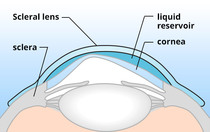Scleral Lenses
Scleral contact lenses were first developed more than a century ago and were commonly prescribed in the 1950s and 60s before the advent of more modern gas permeable rigid and soft lenses. The original scleral designs were actually molded to the eye and then lathe cut and polished to improve the fit and create optics for sight. The main problem with these original large scleral lenses was they did not allow sufficient oxygen to sustain eye health.
Today, modern gas permeable materials and computerized lens manufacturing technology have resulted in an amazing scleral lens renaissance. Scleral lenses can be manufactured in a number of different diameters, some up to twice the diameter of the cornea or about 24mm. Depending on the condition, mini-scleral lenses may be fitted. They are usually 18mm or less in diameter and may be easier to insert and remove for some patients.
CONDITIONS SCLERAL LENSES TREAT
Scleral lenses excel in treating a number of conditions. In some cases, they are the only way to restore acceptable sight, comfort or function. In general, scleral lenses are ideal for conditions that cause corneal irregularity or scarring. Because of their larger diameter, they vault over problem areas and typically provide correction well beyond what can be achieved using conventional smaller diameter soft and gas permeable lenses.
For skilled fitters, scleral lenses have become a preferred treatment for keratoconus. In pellucid marginal degeneration where corneal thinning and protrusion is primarily in the far inferior aspect of the cornea, scleral lenses have become a necessity for properly managing this complex condition. Scleral designs are also optimal for post-surgical correction as well as in managing post-traumatic scarring and exposure.
With patients with suffer from severe dry eye that cannot be effectively managed by other means, including those with Sjögren’s syndrome, scleral lenses can be a lifesaver. By essentially sealing the ocular surface off from the external environment, properly fitted scleral lenses can restore comfort and function when all else fails.
FITTING SCLERAL LENSES
As with most complex lenses, scleral designs require on-eye trial lens fitting. However, modern technology can speed and improve that process, adding precision and enhanced lens performance. Corneal topography assessment assists in selecting the initial trial lens and imaging using state-of-the-art optical coherence tomography can help precisely refine the fit, improving lens comfort and visual performance. The more complex the problem, the more important technology becomes in assuring an optimal fit.
Our doctors have extensive experience fitting scleral lenses for a variety of conditions. Fitting time varies with complexity, but rest assured that our goals is to achieve the best possible results as quickly as possible. Because of the time and cost of materials involved, the fees for fitting scleral lenses are not insignificant; however, many vision care and some medical insurance plans may cover at least some of the cost.







